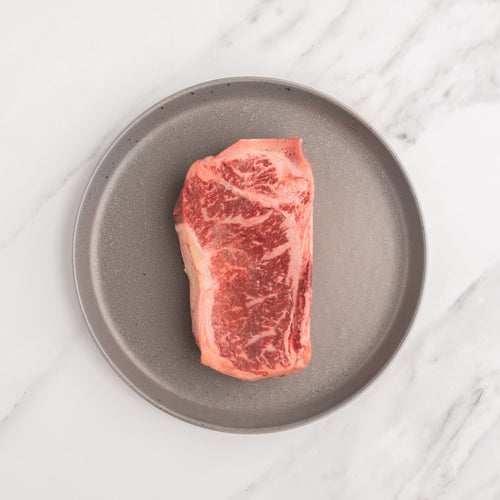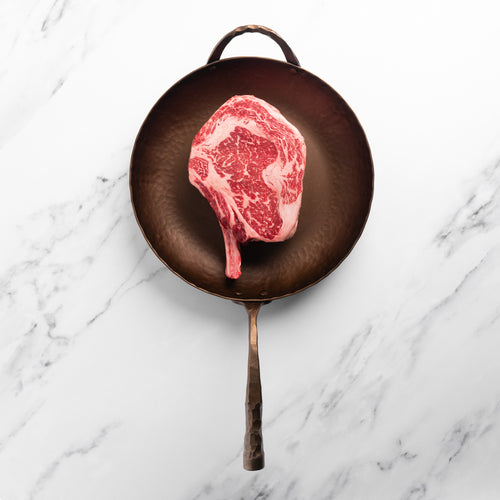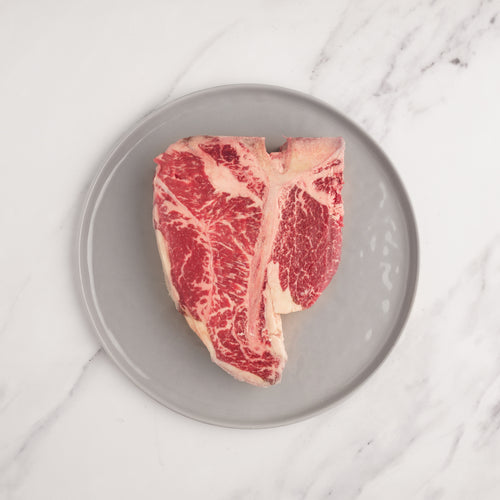
How to Cook Wagyu Steak
Want to know how to cook Wagyu steak like the pros? With its rich marbling and luxurious texture, Wagyu deserves special attention—and the right technique makes all the difference. Whether you're preparing a steakhouse-style dinner at home or trying this prized cut for the first time, a few pro tips will help you get it just right.
Learn how to cook Wagyu steak to perfection with the best techniques and tips to enjoy a tender, juicy, and flavorful dining experience.
|
Table of Contents |
Choosing the Right Cut
As anyone who has surveyed a meat counter knows, there are many different steak cuts. Steak is defined as “a thick cut of beef” which doesn’t narrow down your choices. The most popular cuts are the ones featured on steakhouse menus, and all come from the rib and loin sections of beef cattle.
These include:
-
Ribeye - The ribeye is intensely marbled with a bold beefy flavor and tender texture. The ribeye has a center eye and an outer cap of ribeye separated by a swath of fat. Look for thick cut steaks with abundant flecks and streaks of marbling.
- Strip – A strip steak is highly marbled with excellent flavor and a slightly firm texture. Each steak has an external fat cap on one side and a large uniform section that is easy to slice and yields very little waste.
- Filet Mignon – Prized for its incredible tenderness and mild flavor, the filet mignon has a fine buttery texture that melts in your mouth. A boneless cut without a fat cap and light marbling, this steak has a mild beef flavor.
- Sirloin – Lean, flavorful, and a bit on the chewier side, sirloin is one of the most popular cuts for good reason. It’s more budget-friendly than the steaks listed above, making it a smart pick when you're serving a crowd.
Explore our full lineup of American Wagyu

Preparing Wagyu Steak
Preparing American Wagyu steak starts well before it hits the heat. In the section below, we’ll walk through essential steps like thawing, seasoning, and bringing your steak to room temperature. Each one is designed to help you get the most out of your investment.
How to Properly Thaw Wagyu
Frozen steaks retain their quality when slowly thawed in a refrigerator. Set frozen steaks on a plate or rimmed pan to catch any drips and place in the refrigerator. Thin steaks will thaw overnight, and larger steaks may take 48 hours. Plan ahead and thaw slowly to maximize the quality of Wagyu steaks.
Meat scientists at Texas A&M have found that quickly freezing and slowly thawing beef has little to no impact on quality. At Snake River Farms, we use a blast freezer set to -20°F to reduce freezing time and minimize the formation of ice crystals, helping preserve the steak’s texture and flavor.
Want a step-by-step guide? Check out our full article on how to thaw a Wagyu steak to make sure your steak is perfectly prepped every time.
Should you Season Wagyu?
Wagyu beef possesses a rich flavor which is enhanced by simply seasoning with kosher salt. If preparing Wagyu for the first time, this is an excellent way to discover its unique flavor profile.
Even with its rich, beefy flavor, don’t hesitate to use your favorite seasonings and rubs. Personal preference plays a big role in finding the best way to season your Wagyu steak.
Looking for the perfect finishing touch? Explore our full selection of gourmet salts to enhance the flavor of your Wagyu steak.
Bringing the Steak to Room Temperature
Many chefs and grill masters recommend letting a steak sit at room temperature so it will cook quickly and evenly. This is a tip that you’ll also find in many books and websites.
J. Kenji Lopez-Alt, James Beard award winning author of The Food Lab took the time to put this to the test and found resting at room temperature has little impact on the finished quality of a steak.
If you decide to let your steak sit at room temperature prior to cooking, do not let it sit longer than 2 hours – the maximum amount of time the USDA recommends for food safety.
Cooking Methods for Wagyu Steak
Cooking Wagyu steak requires a thoughtful approach to highlight its exceptional marbling and flavor. Below, you'll find three proven methods: pan searing, grilling, and sous vide. Each technique offers a unique way to bring out the best in your steak.

Pan-Seared Wagyu
This simple method sets an even, golden brown crust on a steak’s exterior and allows the option of adding flavor through the use of aromatics and butter-basting.
This simple method sets an even, golden brown crust on a steak’s exterior and allows the option of adding flavor through the use of aromatics and butter-basting.
- Best Pan to Use – A cast iron pan is the ideal tool for pan-searing steaks. A thick heavy pan holds heat for a long period of time and sears a steak quickly so the interior does not overcook.
- Best Oil or Cooking Medium – A neutral vegetable oil is a good choice for pan-searing steaks. There are many sources that cite the benefits of Wagyu tallow which has a high smoke point and imparts additional flavor to the steak. It’s an excellent option if you have it on hand.
Pan-Searing Guide
-
Season
Heat a heavy skillet (cast iron is ideal) over medium heat until hot. Add a light coat of vegetable oil to the skillet. Season top side of steak with salt and pepper. -
Sear
Place steak, seasoned side down, in skillet and sear 4 to 5 minutes until nicely browned. If the steak sticks to the skillet, it’s not ready to turn. Wait until it releases on its own. -
Flip
Turn steak over and allow to cook for an additional 3 to 5 minutes. After 2 to 3 minutes, use a thermometer to test the thickest part of the steak. When the temperature reaches the desired level, remove from the skillet. Serve.
Want to see the pan-searing method in action?
Watch our quick how-to video to learn how to achieve a perfect crust, use aromatics like a pro, and finish your steak with a rich butter baste:


Grilling Wagyu
Grilling steak is a time-honored method, especially popular during the warmer months. Charcoal grilling, in particular, adds distinctive flavor and texture. While any cut can be grilled, thick steaks (at least 1 ½") with more marbling such as ribeye or strip steak are preferred.
Use a 2-zone set-up with your grill. For charcoal, put all the hot coals on one side and leave the other side empty. This creates a hot side for searing and a cool side for bringing the steak to your preferred temperature. This also gives you a side to move the steak as melted fat hits the coals and flares.
Grilling Guide
- Generously season steak with kosher salt.
- Set up your grill with 2 cooking zones, leaving the vents open all the way.
- Place steaks on the cool side of the grill and close the lid. Flip the steaks and check their temperature every 3-4 minutes. The targets are 110°F for medium-rare or 120°F for medium.
- When the desired temperature is reached, move the steaks to the hot side of the grill to do a final sear. About 1 minute per side. It’s fine to flip the steaks again if you desire a deeper char.
- Remove the steaks and place on a cutting board. Rest 5 to 10 minutes. Serve.
Want to level up your grilling game?
Check out these expert tips and guides to help you get the most out of your grill set-up:
Gas, Charcoal, or Wood? Here's How Each Impacts Flavor
Ready to see it in action
Watch this quick video for a step-by-step look at the 2-zone grilling method and tips to get that perfect sear every time:


Sous Vide Wagyu
Sous vide is a surefire method to cook a Wagyu steak with an interior that is evenly pink and juicy from edge to edge. It’s the ideal method for anyone who wants total control and consistent, even results every time.
Sous vide temperatures differ from conventional methods. Since the steak is cooked in a moist environment, it’s best to use higher temperatures. Set your immersion circulator (the sous vide device) to these temperatures:
- Rare - 115°F
- Medium-rare - 125°F
- Medium - 135°F
The time to cook a steak using sous vide varies depending on its size and thickness. In general, the minimum cook time is 1 hour. While it’s technically possible to sous vide a steak for several hours due to the precise temperature control, cooking it too long can result in a steak with an overly soft texture. Filet mignon should be cooked for less time since this cut has less marbling and can dry out more easily.
- Rare - 1 to 2 hours
- Medium-rare – 1 to 3 hours
- Medium – 1 to 4 hours
For food safety reasons, do not cook steaks for more than 3 hours when the temperatures is set at less than 130°F.
Sous Vide Guide
- Set up a water bath and select the desired temperature on the immersion circulator.
- Generously season steak with kosher salt.
- Place steak in a vacuum seal or ziplock bag. Add aromatics like garlic, rosemary, etc. if desired. Seal bag.
- Set the sealed bag in the water bath and cook using the recommended times.
- When ready, pull the bag from the water bath. Open the bag and remove the steak. Place on a plate and pat dry with paper towels.
- Coat a cast iron pan with a layer of neutral vegetable oil and heat over high heat.
- When the oil begins to smoke, place the steak in the pan and sear for about 1 minute. Flip and sear the other side. The steak is fully cooked, so sear just long enough to set a golden crust.
- If preparing a thick steak, use tongs to hold the steak on edge and sear the sides.
- There’s no need to rest a sous vide cooked steak. Serve immediately.
Curious how sous vide works with American Wagyu?
Watch this step-by-step video to see how sous vide delivers edge-to-edge perfection—and how to finish with a sizzling sear that locks in flavor.

Resting and Serving Wagyu Steak
Once you’ve cooked a beautiful steak, it’s important to properly rest and serve it. In the preparation instructions above, there is a note to rest your Wagyu steak. After the steak has reached your desired temperature, place it on a cutting board and let it rest for 5 to 10 minutes.
Resting allows the temperature to equalize throughout the entire steak and gives time for the muscle fibers to reabsorb the natural juices. If you cut a steak open when it comes directly off the grill or skillet, it will release the juices onto the cutting board. This is a simple step that makes a big difference.
Steaks are the most tender when sliced against the grain. The muscle fibers of a steak run in a specific direction which is with the grain. Cutting the steak perpendicular to the grain shortens the muscle fibers and makes the steak more tender.
Common Mistakes to Avoid
-
Overcooking your Wagyu steak
Cooking to high temperatures causes the muscle fibers to contract and displace the moisture and fat making a steak tough and dry.
-
Using too much (or not enough) seasoning
Wagyu steaks are naturally flavorful, but seasoning with kosher salt is a fundamental enhancer and helps beef’s inherent qualities blossom. Using your favorite rub with aromatics and seasonings adds additional flavor components.
Conversely, using too much salt or rub overpowers the natural Wagyu flavor and has a negative effect on a steak’s natural goodness.
-
Not resting properly
Resting your steak allows the temperature to equalize throughout the entire cut and the natural juices are reabsorbed. Skipping this crucial step results in a loss of the juices.
Avoid the most common steak mistakes—Wagyu deserves better. Take your technique to the next level with these tools and tips designed to help you cook with confidence:
The #1 Tip for Cooking Steak Perfectly Every Time
Explore Our Collection of Salt & Gear
Shop the Superfast Thermometer
Go Forth and Grill
Here’s a quick recap of key tips to help you cook American Wagyu like a pro:
- Choose the cut that suits your taste and occasion.
- Thaw your steak slowly in the fridge for the best texture.
- Season simply with kosher salt—or use your favorite rub to layer on flavor.
- Pick a cooking method that fits your style and gear: grill, pan-sear, or sous vide.
- Use a meat thermometer for precision—don’t rely on guesswork.
- Let your steak rest for 5 to 10 minutes before slicing and serving.
American Wagyu is more than a meal—it’s an experience. With just a little preparation and the right technique, you’ll serve up a steak that’s rich, tender, and unforgettable. Now fire up that grill (or cast iron) and enjoy the delicious difference.







